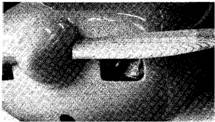FREE
ENTERPRISE
Many
of you have probably already seen pictures of the newest project around
QAC, the FREE ENTERPRISE.
No, it is not going to be a kit airplane! It
was designed and developed to fly around the world non-stop and unrefueled,
a feat never before accomplished by any aircraft.
Testing is progressing well toward a departure
in May, 1982; the aircraft has become a flying testbed for many new ideas in
airframe and propulsion
systems that may turn up in future projects. The aircraft will remain
a one-of-a-kind vehicle. We are currently negotiating with several prospective
sponsors for the record
attempt.

Eight
Q2’s have flown as this is being written; another dozen
builders indicate that they are within 30 days of flying; over 700
more are under construction.
The prototype C-85 Continental installation being done by one of the
builders is proceeding slowly. We expect to have some flight test data
by June.
|
In
the last issue, we covered the subject of canard surface waviness. As a
result of a recent article in Sport Aviation
and some flight test investigation that we have accomplished, further comments
are in order. The surface waviness criteria called out in the plans (page
3-18 in the Q2 plans; page 19-7 in the Quickie plans) is 0.005” per
2” gauge length maximum. Above this limit, the maximum lift capability
of the canard will be reduced significantly. One builder painted three
stripes on the leading edge of his canard; no attempt was made to feather-
in the edges when the masking tape was removed, resulting in three stall
fences. Therefore, the surface waviness of his upper canard under those
conditions probably exceeded 0.0 12” per two inch gauge length along
the entire span of the canard, resulting in a much reduced canard lift
capability. After removing the three stripes, the builder spent further
time smoothing the canard surface to tolerances of less than 0.005” per
2” length. The result was superior lift even compared to the original
aircraft before the stripes were added.
Recently, Dave Elliot
at QAC spent a few hours recontouring the canard on N8IQA to within 0.002”-0.003” per 2” gauge
length. The stall speed on N81QA has dropped over 4 mph. as a result of |
the modification. Obviously,
not every builder will smooth his canard to that extent, but the message
is obvious - extra
work on the leading edges of the canard can appreciably improve performance.
Recently,
QAC has also been testing a Warnke ‘almost constant speed
prop’. This propeller is a laminated wood design configured to change
its twist in flight aeroelastically. The result is more static and climb
r.p.m. without overspeeding the engine at cruise. No mechanical or hydraulic
techniques are used, making the propeller relatively inexpensive at about
$250.00. We currently have Mr. Warnke fabricating a second propeller as
the first one did not have sufficient pitch at high speed. Nevertheless,
the results are extremely encouraging; N81QA can have 1000 feet of altitude
after takeoff by the end of a 4000 foot runway! We will keep our builders
informed of developments. continued on page 2
 |

